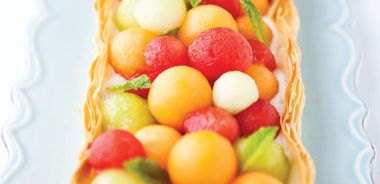Mixed Melon Tart

This tart is a light and refreshing way to crown a meal. You can prepare all the parts ahead of time so that all you do is assemble before serving. Goats’ milk yogurt adds an extra depth of flavour to the tart, but it can easily be replaced with plain yogurt.
2 cups (500 mL) low-fat goats’ milk yogurt
3 sheets phyllo dough, thawed
2 Tbsp (30 mL) coconut oil, melted, plus extra
1/4 cup (60 mL) finely chopped almonds or hazelnuts
2 Tbsp (30 mL) honey, divided
1/2 vanilla bean, split and seeds scraped out
1 tsp (5 mL) lime zest
1 Tbsp (15 mL) lime juice, divided
1/8 tsp (0.5 mL) ground cardamom
3 cups (750 mL) mixed melon balls or cubes (such as watermelon, honeydew, or Sharlyn)
Line sieve or colander with wet cheesecloth and place over bowl. Place yogurt into cheesecloth, wrap cheesecloth overtop yogurt to cover and place plate on top of yogurt. Allow yogurt to drain in refrigerator overnight.
Preheat oven to 375 F (190 C).
Unroll phyllo on clean work surface. To prevent phyllo from drying out, cover with barely damp towel. Working with 1 sheet of phyllo at a time, lightly brush dough with coconut oil and sprinkle with ground almonds. Lay another sheet of phyllo overtop and brush with more oil and sprinkle with almonds. Repeat with last layer of phyllo.
Take one of the long edges and fold it over to meet the other edge. Brush phyllo again lightly with oil and use it to line a 13 1/2 x 4 1/2 in (34 x 11.5 cm) pan with removable bottom that has been lightly greased with coconut oil. Trim overhanging pastry with scissors to be flush with edge of pan, and prick bottom of phyllo with fork.
Press a piece of parchment paper into bottom and up sides of phyllo crust, and scatter a handful of dried beans or pie weights over parchment to weigh it down. Bake until edges are golden brown and bottom is dry and crisp, about 10 minutes. Let cool in pan on a wire rack.
Place drained yogurt in large bowl and discard drained liquid. Stir together yogurt, 1 Tbsp (15 mL) honey, vanilla seeds, lime zest, and 1 tsp (5 mL) lime juice. Cover and refrigerate until ready to use.
In large bowl, whisk together remaining honey, remaining lime juice, and cardamom. Add melon and stir to coat in dressing. Let sit at room temperature for 30 minutes or refrigerate until ready to use.
When ready to serve, spread yogurt filling into phyllo crust and top with melons. Slice and divide among serving plates. Drizzle with any remaining dressing left in bowl from melons. Assemble tart no more than 20 minutes before serving (or pastry will get soggy).
Serves 6.
Each serving contains: 221 calories; 7 g protein; 10 g total fat (7 g sat. fat, 0 g trans fat); 24 g total carbohydrates (15 g sugars, 1 g fibre); 130 mg sodium
source: "Melon Madness", alive #370, August 2013





